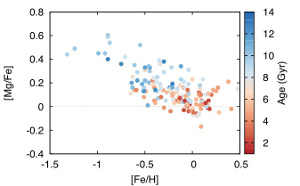|
|  |
One of the key quests in modern astrophysics is to understand how
galaxies form and evolve. Observations of their luminous constituents,
the stars, provide important constraints on this problem. We can
barely resolve individual stars in other galaxies, and thus have to
rely on their composite, mass-function integrated, spectra. But, with
the Milky Way we are in a unique position: one of the most massive
members of the Local Group can be studied in great detail from the
inside.
Modern telescopes are able to catch light from stars populating all
galactic components: the bulge, the disk, and the halo. Using observed
spectra and stellar evolution theory, we can determine the chemical
composition and the ages of stars. With sufficiently large datasets,
we can then reconstruct how chemical enrichment in each of the
components varied over time, i.e. what nucleosynthesis processes took
place and at which rate the heavy elements were injected to the
interstellar medium. This information is complemented with stellar
kinematics and forms the observational basis for studies of galactic
chemo-dynamical evolution.
The Gaia-ESO Survey (GES) is based on this core idea. The survey is
a spectroscopic extension with ground-based telescopes to the Gaia
astrometric space mission (ESA). GES has been awarded 300 nights
on the Very Large Telescope in Chile, the largest ever allocation on a
8-10m telescope, and will acquire spectra for about 100,000 stars,
probing distances as large as 15 kpc. (For comparison: The distance
from the Sun to the galactic centre is about 8 kpc or 26,000
light-years.) Fig. 2 shows the coverage map of the Milky Way
field. The spectra will be uniformly analysed with state-of-the-art
models of stellar atmospheres and stellar evolution to complement the
data. The uniqueness of the survey comes from its ability to map the
detailed chemistry of all stellar populations homogeneously and with
good statistics.
The complete dataset will have enormous potential, but the first
interesting results have already been obtained. The preliminary
analysis has yielded detailed measurements of ages and metallicities
for stars in the solar neighbourhood. Contrary to most previous
surveys, we are now able to add new dimensions to this data, for
example, the abundances of different elements such as magnesium (Mg).
In the metallicity range -0.5 < [Fe/H] < +0.5, which is typical of the
Milky Way thin disk, stars can be found with any age between 1 and 10
Gyrs. But as the metallicity decreases further, the stars become
markedly older and show significantly larger abundances of alpha
elements, which are synthesized in nuclear alpha-capture
reactions. Thus the elevated levels of magnesium are a clear signature
that core-collapse supernovae dominate the enrichment of this stellar
population. But also stars with low, solar-like [Mg/Fe]-ratios display
a large range of ages (Fig. 3). Does this support the current views on
the formation of our galaxy? Some models are indeed bolstered by these
findings, such as for example, the models with radial migration. These
predict a significant spread in magnesium content and age for any
given metallicity in the disk, just as observed.
This is just the beginning. In a few years, GES will have
accumulated sufficiently large, statistically-significant datasets to
make firm statements about stellar evolution and chemical
enrichment. They will undeniably set a new point of reference in
observational galactic astronomy, perhaps breaking old paradigms and
bringing fresh ideas to help understand how our Milky Way came to be.
Maria Bergemann and the Gaia-ESO Survey team
Note:
The GES team includes more than 300 co-Investigators from 90
institutes worldwide. The survey is lead by G. Gilmore (IoA,
Cambridge) and S. Randich (INAF-Arcetri). MPA is represented by
M. Asplund, M. Bergemann, K. Lind, A. Marino, G. Ruchti, A. Serenelli.
References:
Gilmore, Randich et al.,
ESO Messenger 147, 2012
|




